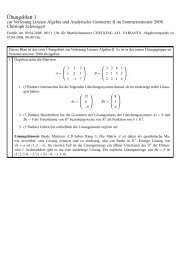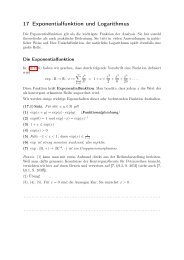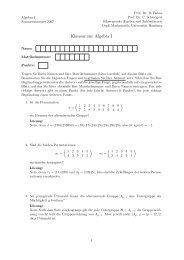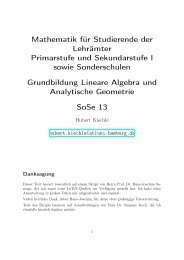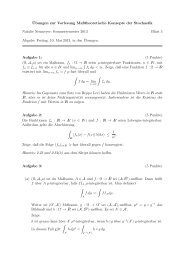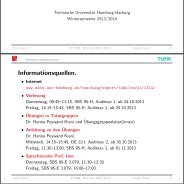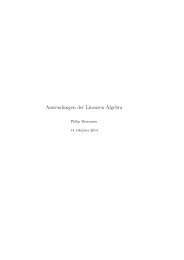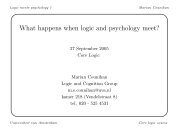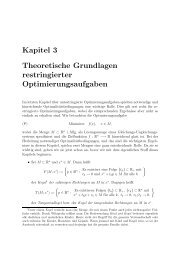pdf file
pdf file
pdf file
Create successful ePaper yourself
Turn your PDF publications into a flip-book with our unique Google optimized e-Paper software.
Lemma 3.3.10.<br />
Let a ∈ G(H) be the distinguished group-like element of H and t, γ as before.<br />
1. Then (S(t (1) )a, t (2) ) are dual bases for γ.<br />
2. We have for the Nakayama automorphism for the Frobenius structure given by the right<br />
integral:<br />
ρ(h) = a −1 S 2 (h (1) )〈α, h (2) 〉a .<br />
Proof.<br />
• Using the definitions, we find for all h ∈ H:<br />
S(t (1) )a〈γ, t (2) h〉 = S(t (1) )t (2) h (1) 〈γ, t (3) h (2) 〉 [γ right cointegral]<br />
so that we have dual bases.<br />
= h (1) 〈γ, th (2) 〉 = h (1) ɛ(h (2) ) = h<br />
• By the fact that we have dual bases, we can write<br />
ρ(h) = S(t (1) )a〈γ, t (2) ρ(h)〉 = S(t (1) )a〈γ, ht (2) 〉 ,<br />
where in the second identity, we applied the definition of the Nakayama automorphism.<br />
Applying S −2 and conjugating with a, we find<br />
aS −2 (ρ(h))a −1 = a〈γ, ht (2) 〉S −1 (t (1) )<br />
= h (1) t (2) 〈γ, h (2) t (3) 〉S −1 (t (1) ) [γ cointegral]<br />
= h (1) 〈γ, h (2) t〉 = h (1) 〈α, h (2) 〉 .<br />
Conjugating with a −1 and applying S 2 yields the claim.<br />
✷<br />
Observation 3.3.11.<br />
If H is a finite-dimensional Hopf algebra, then H ∗ is a finite-dimensional Hopf algebra as well.<br />
We then have the structure of a left and right H ∗ -module on H by<br />
h ∗ ⇀ h := h (1) 〈h ∗ , h (2) 〉 and h ↼ h ∗ := 〈h ∗ , h (1) 〉h (2) .<br />
This can be checked again graphically.<br />
Theorem 3.3.12 (Radford,1976).<br />
Let H be a finite-dimensional Hopf algebra over a field K. Let a ∈ G(H) and α ∈ G(H ∗ ) be<br />
the distinguished modular elements. Then the following identity holds:<br />
S 4 (h) = a(α −1 ⇀ h ↼ α)a −1 = α −1 ⇀ (aha −1 ) ↼ α<br />
Proof.<br />
77






